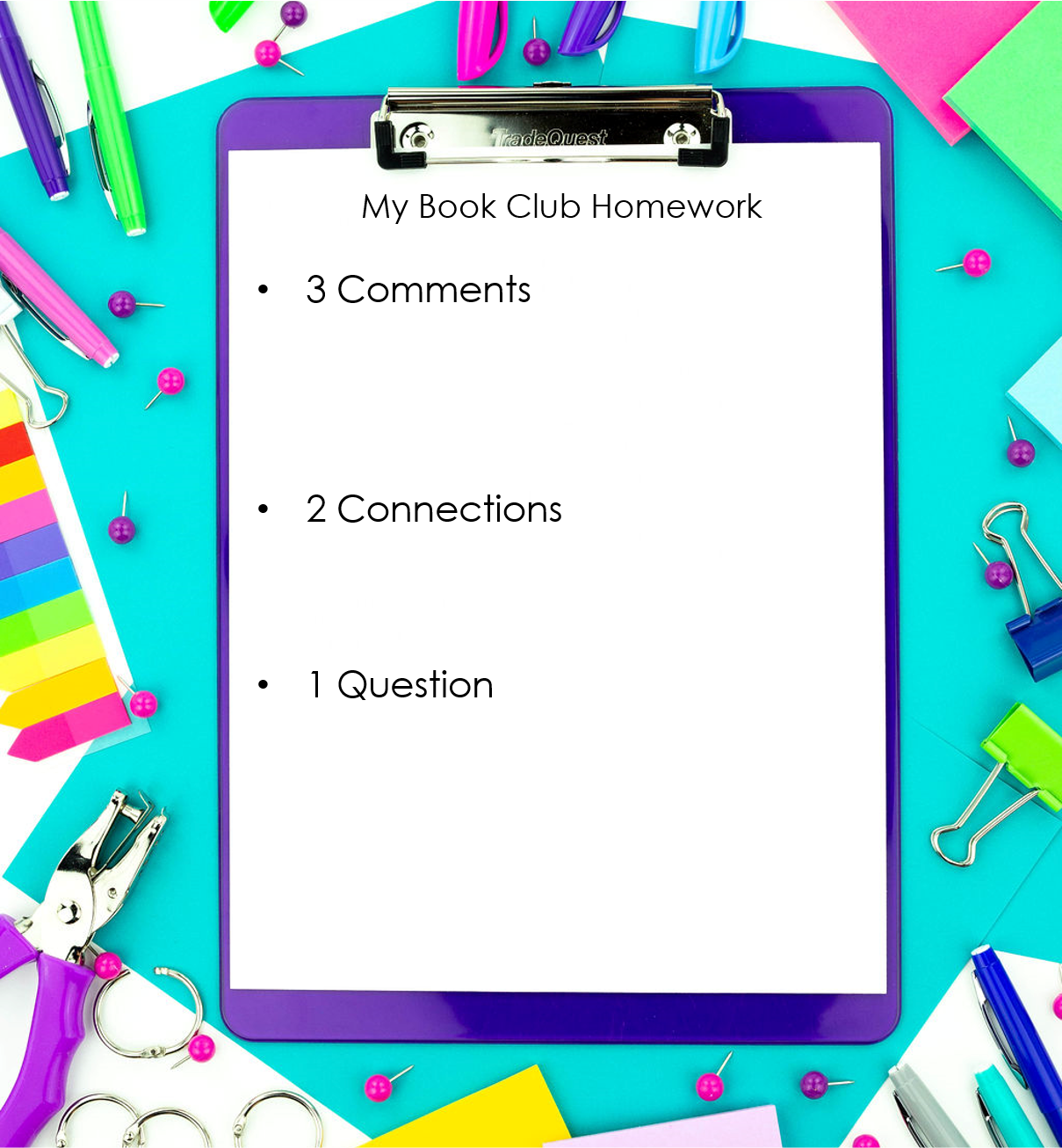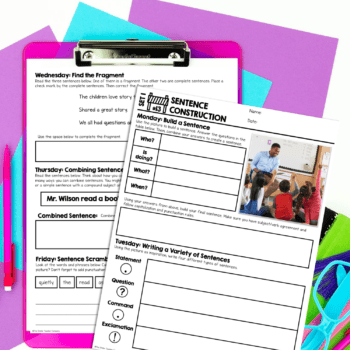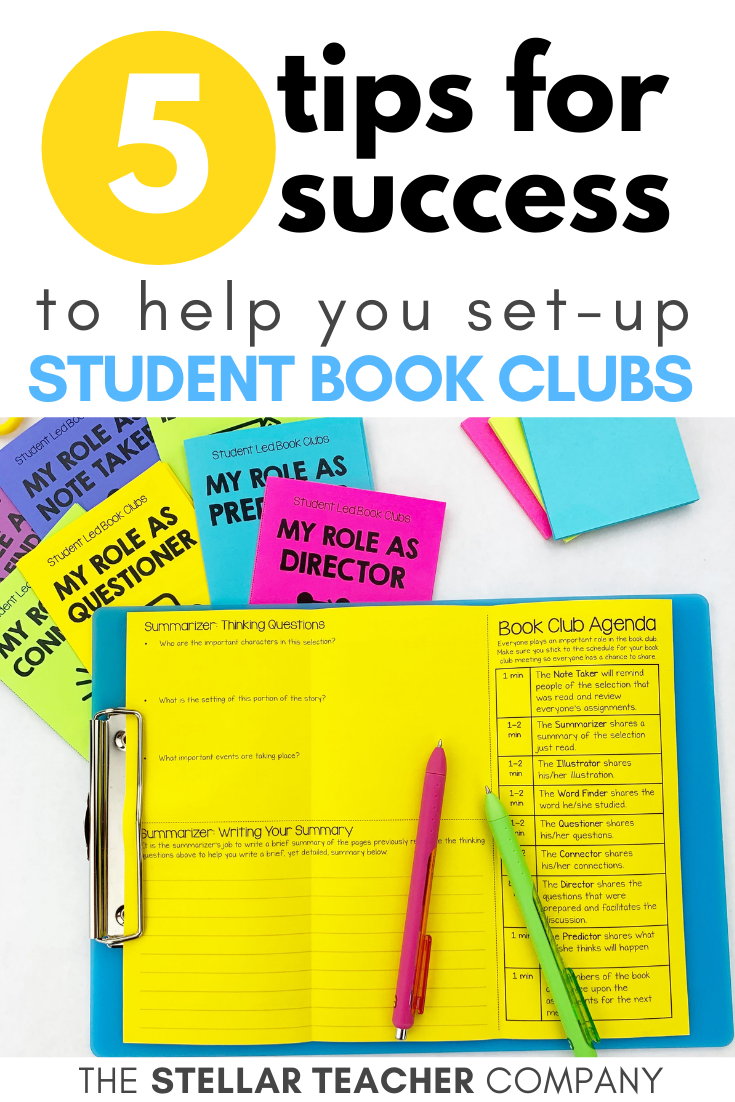Does anyone else struggle with setting up book clubs in the classroom?
On the surface, a book club always sounds like a great idea! But, (if you’re like me), you may have fallen into the trap of pushing back the date that you actually start book clubs in the classroom with your students, because you can’t seem to find the time to prep all of the things that you feel like you need to have ready to ensure that your students’ book clubs are successful.
The truth is, book clubs are for the students, and they do not need to have months of prep work behind them. If you have found yourself spinning your wheels trying to get everything organized enough to simply start book clubs, then I have 5 tips for you today that will help you get your classroom book clubs up and running this week!

What is a student-led book club?
Book clubs, formally known as a literature circles in many places, are a shared reading experience among a small group of students. The goal is that the students are facilitating the discussion, rather than the teacher leading the group, as you would see in a traditional small group.
Students meet according to a set schedule, and practice the reading skills you have been teaching them through their own text-based discussion. It’s another way to incorporate independent skill practice into your reading block!
How will book clubs in the classroom help my students?
Book clubs in the classroom are one of the most authentic reading experiences you can give your students. Reading a book, and engaging in discussion with peers over that book is exactly how we approach reading as adults. Additionally, positive book club experiences in elementary school can encourage students to continue reading as they get older.
The more positive reading moments we can curate in our classrooms, the better job we are doing of creating lifelong readers, which is our ultimate goal!

5 Ways to Get Book Clubs in the Classroom Up and Running
Have a Clear Agenda/Routine for Each Book Club
There is no wrong way to do a book club. You may have internalized the idea that you need to have dozens of jobs set up and taught before you can officially place students in a book club. There is nothing inherently wrong with incorporating different roles into your students’ book clubs, but if this has been holding you back from getting started,
I want you to know that jobs are not necessary for book club success! The real key to hosting well-run book clubs is to have a clear agenda. Students thrive when things are consistent and predictable. Explicitly stating what should be done during book club, and for how long, gives your students the parameters they need to be successful, while also keeping things loose enough for their discussion to be their own.
Some items that a book club agenda may include:
Summarize yesterday’s reading: 5 minutes.
Share connections: 3 minutes.
Discuss predictions: 5 minutes.
Ask questions: 2 minutes
…or whatever you want to include!

Introduce Your Book Club Structure in Whole Group
This was a lifesaver for me. If you have created a routine that will be the same for book clubs, no matter which students are in it, and regardless of the text that is being read, then you can teach the routine one time to everyone. Put students in their groups during your typical book club time, but read one text to everyone aloud. Then, have students practice the discussion routine you created in their small groups over the text you read them.
This allows you to circulate and give feedback to the discussion of different groups, without having to hold 4-6 different texts in your head. Establishing the routine well on the front end will be a lifesaver for you as you release the responsibility to your students in the future.

Use Picture Books as Your Book Club Text
This is not as common, especially in upper elementary, but I am a big believer in using picture books as a teaching tool across all grades…even in book clubs! There are no rules that state that book clubs have to last for weeks at a time, or that they have to use chapter books.
If the purpose of a book club is for students to have a shared reading experiences, then any text will do! Using picture books can be a great way to further establish the routine of small group discussion with shorter texts.

You can use picture books in a few different ways:
Introduce a handful of picture books to your students, and let them choose which book club they would like to be a part of.
Pull several picture books by the same author, and create author study book clubs.
Pull several picture books that are the same genre, and host genre study book clubs!
Let Students Choose their Texts
This raises plenty of concern for teachers everywhere, and I understand it. We want to make sure that our students are reading texts at an appropriate level, that they are on task, and (most importantly), that they are learning through book clubs in the classroom. But, offering choice is such a powerful tool in our teaching. If you are hesitant to allow students to choose their book club texts, I’d like to offer a couple of points for consideration.
Choice is an automatic engagement-booster. When students choose, they are inherently more invested in the task at hand. Assigning a text that a student has no interest in, simply because it’s the right lexile level for them, will not promote engagement in the reading, which won’t help your students grow.
Engagement in a task promotes grit. If the text is a tiny bit harder than you may have chosen for the student yourself, the fact that they chose it can be enough to encourage them to work harder to comprehend than they may have if the book were handed to them.
Positive reading experiences produce more reading experiences. Forcing a student into a group they didn’t want can have the opposite effect of what we’re looking for in our book clubs. If a text is a little too easy, or a little too hard, but the student desperately wanted to see what would happen, and they were enjoying learning from the other students in the group, then they will be more apt to pick up a book in their free time.
Create 5-6 different book clubs, and allow students to sign up for the one they prefer. Yes, some of your students’ may end up in groups with their very best friends. But again, this mirrors real life, and we are trying to create authentic reading experiences! If you are worried about off-task behavior between friends, I’d encourage you to make sure that your routine is clear and tight to eliminate space for off-task discussions.
Another option you can consider is letting your students select their book club right before or after an extended break. We all know how antsy students can get right before a holiday break. And as teachers we are looking for all the help we can get during those crazy weeks. Giving students the chance to select their own book club can be just one simple way you boost engagement right before the holidays.
Minimize and Simplify Book Club Homework
The traditional book club routine is for students to both read and complete several discussion questions independently. I don’t recommend that you pile on the homework, because (again) we want to create a shared, positive reading experience for our students!
Instead, I recommend allowing your students to decide as a group how many chapter they would like to have read each week, and then creating a one-size-fits-all assignment for each group to complete before each book club meeting.
For example, you could ask students to come to each book club prepared to discuss:
Three comments
Two connections
One question that you had
An assignment like this can be written on any kind of paper, so no copies are necessary, and puts the responsibility on your students’ shoulders, rather than creating an extra task your weekly to-do list!

Your time is better spent teaching than facilitating, after all.
These 5 tips will help your students run their own book clubs in the classroom, and allow you to truly sit back and observe. Instead of running the book clubs yourself, you can spend time providing feedback to your students that will deepen their discussion, and help them grow as readers!!
Extra F. A.Q’s About Book Clubs in the Classroom
How often should I have book clubs running?
There is no magic number here…you get to decide! You can have them run for one month, each quarter. Or, maybe you have students rotating through book clubs for the entire second semester.
One thing I would consider is if your students are also in guided reading groups, are you providing enough space for them to balance all of their assignments and hold all of those texts in their heads?
Do I have to read the book before my students?
Best practice tells us, yes; we should know exactly what a text is about before we assign it to our students. But, reading every book in its entirety may not be feasible. So, if you don’t have time to read a book to completion, at least make sure that you have done some research to ensure that inappropriate themes are not present in the book and that you’ve read a few chapters to familiarize yourself with the complexity of the vocabulary!
Should I assign roles for each student in the book club?
There are pros and cons to roles! There is a lot of structure added when you incorporate student jobs into book clubs. So, if structure and keeping students busy the entire time is the most important thing to you, then you may want to use specific jobs. However, some of the cons may be that you are not creating as authentic of a reading experience as you may have wanted. When adults discuss books with their peers, they aren’t looking only for their questions, or only for their connections. They are looking at the text as a whole.
Another con is that roles create extra prep work for the teacher. The teaching on the front end needs to be more in-depth to cement all of the different routines for the different jobs, and often different roles require different types of writing assignments, which may mean more copies.
At the end of the day, it’s just about your preference and teaching style! I hope you enjoy book clubs in the classroom.
Happy Teaching!
Want to learn more about how to get started with book clubs in the classroom?
Check out this episode of Stellar Teacher TV where I share some of my best tips for getting started with book clubs.
Sentence Writing Routine Free Sample
If your students struggle to write at the sentence level, this new literacy routine is going to be your new best friend. Each day of the week your students will engage in a quick (yet effective) sentence writing task that will help them become more confident and creative writers. Say goodbye to fragments and boring sentences, and say hello to complex sentences with lots of details!



















Leave a Comment
You must be logged in to post a comment.